Rainbow Flag: Orgin story
The story behind the creation of the Rainbow Flag
Excerpts from Gilbert Baker’s Memoir, RAINBOW WARRIOR
Published with Permission of Sterling Lord Literistic
The following paragraphs are from chapter 5 “Stitching A Rainbow” where Gilbert describes the moments where he came up with the ideas behind the creation of the Rainbow Flag for the LGBTQ Community.
Here Gilbert recalls an evening with his friends Cleve Jones and filmmaker Artie Bressan in early 1978, after his Christmas breakup with Tandy Belew.
“To get over Tandy, I devoted myself further to activism and went to the movies. My friend Artie Bressan, Jr., was a filmaker who had just made a documentary of the 1977 Parade, titled “Gay USA.” He was a wild visionary who directed porn on the side to finance his 35mm documentaries. We went to see films several times a week.
One day, we went to the Strand Theater on Market Street to see Citizen Kane. It was Artie’s favorite. Cleve joined us. After the movie, we all walked over to Civic Center Plaza to look at the neoclassic buildings. Artie began to press me to come up with a new symbol for what he had called “the dawn of a new gay consciousness and freedom.” Both he and Harvey had brought this up to me before.
At this point, the pink triangle was the symbol for the gay movement. But it represented a dark chapter in the history of same-sex rights. Adolph Hitler conceived the pink triangle during World War II as a stigma placed on homosexuals in the same way the Star of David was used against Jews. It functioned as a Nazi tool of oppression. We all felt that we needed something that was positive, that celebrated our love.
As Artie implored, I looked at the flags flying on the various government buildings around the Civic Center. I thought of the American flag with its thirteen stripes and thirteen stars, the colonies breaking away from England to form the United States. I thought of the vertical red, white, and blue tricolor from the French Revolution and how both flags owed their beginnings to a riot, a rebellion, or revolution. I thought a gay nation should have a flag too, to proclaim its own idea of power.
As a community, both local and international, gay people were in the midst of an upheaval, a battle for equal rights, a shift in status where we were now demanding power, taking it. This was our new revolution: a tribal, individualistic, and collective vision. It deserved a new symbol.
In the past, when I had thought of a flag, I saw it as just another icon to lampoon. I had considered all flag-waving and patriotism in general to be a dangerous joke. But that changed in 1976. The American Bicentennial celebration put the focus on the American flag. It was everywhere, from pop art to fine art, from tacky souvenirs to trashy advertising. On every level, it functioned as a message. After the orgy of bunting and hoopla surrounding the Bicentennial, I thought of flags in a new light. I discovered the depth of their power, their transcendent, transformational quality. I thought of the emotional connection they hold. I thought how most flags represented a place. They were primarily nationalistic, territorial, iconic propaganda — all things we questioned in the ‘70s. Gay people were tribal, individualistic, a global collective that was expressing itself in art and politics. We needed a flag to fly everywhere.”
Later that week at the Winterland Ballroom…
“Cleve and I danced the same way; we always raised our arms up over our heads, snapping our fingers like Diana Ross. We’d shake our hips like Tina Turner, acid cheerleaders twirling in psychedelic funkadelic circles.
The crowd was as much a part of the show as the band. Everyone was there: North Beach beatniks and barrio zoots, the bored bikers in black leather, teenagers in the back row kissing. There were long-haired, lithe girls in belly-dance get-ups, pink-haired punks safety-pinned together, hippie suburbanites, movie stars so beautiful they left you dumbstruck, muscle gayboys with perfect mustaches, butch dykes in blue jeans, and fairies of all genders in thrift-store dresses. We rode the mirrored ball on glittering LSD and love power. Dance fused us, magical and cleansing. We were all in a swirl of color and light. It was like a rainbow.
A rainbow. That’s the moment when I knew exactly what kind of flag I would make.
A Rainbow Flag was a conscious choice, natural and necessary. The rainbow came from earliest recorded history as a symbol of hope. In the Book of Genesis, it appeared as proof of a covenant between God and all living creatures. It was also found in Chinese, Egyptian and Native American history. A Rainbow Flag would be our modern alternative to the pink triangle. Now the rioters who claimed their freedom at the Stonewall Bar in 1969 would have their own symbol of liberation.”
